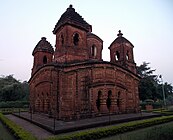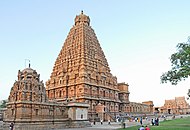 Kandariya Mahadeva Temple, Madhya Pradesh |  Chennakesava Temple, Karnataka |
 Panchchura Temple, West Bengal |  Thanjavur Brihadisvara Temple, Tamil Nadu |



A Hindu temple is a symbolic house, seat and body of god. It is a structure designed to bring human beings and gods together, using symbolism to express the ideas and beliefs of Hinduism. The symbolism and structure of a Hindu temple are rooted in Vedic traditions, deploying circles and squares. A temple incorporates all elements of Hindu cosmos—presenting the good, the evil and the human, as well as the elements of Hindu sense of cyclic time and the essence of life—symbolically presenting dharma, kama, artha, moksa, and karma.
The spiritual principles symbolically represented in Hindu temples are given in the ancient Sanskrit texts of India (for example, Vedas and Upanishads), while their structural rules are described in various ancient Sanskrit treatises on architecture (Brhat Samhita, Vastu Sastras). The layout, the motifs, the plan and the building process recite ancient rituals, geometric symbolisms, and reflect beliefs and values innate within various schools of Hinduism. A Hindu temple is a spiritual destination for many Hindus, as well as landmarks around which ancient arts, community celebrations and economy have flourished.
Hindu temples come in many styles, are situated in diverse locations, deploy different construction methods and are adapted to different deities and regional beliefs, yet almost all of them share certain core ideas, symbolism and themes. They are found in South Asia particularly India and Nepal, in southeast Asian countries such as Sri Lanka, Cambodia, Vietnam, and islands of Indonesia and Malaysia, and countries such as Canada, the Caribbean, Fiji, France, Guyana, Kenya, Mauritius, the Netherlands, South Africa, Suriname, Tanzania, Trinidad and Tobago, Uganda, the United Kingdom, the United States, and countries with a significant Hindu community. The current state and outer appearance of Hindu temples reflect arts, materials and designs as they evolved over two millennia; they also reflect the effect of conflicts between Hinduism and Islam since the 12th century. The Swaminarayanan Akshardham in Robbinsville, New Jersey, United States, between the New York and Philadelphia metropolitan areas, was inaugurated in 2014 as the world's largest Hindu temple.
Contents
Significance and meaning of a Hindu temple
A Hindu temple reflects a synthesis of arts, the ideals of dharma, beliefs, values, and the way of life cherished under Hinduism. It is a link between man, deities, and the Universal Purusa in a sacred space.
In ancient Indian texts, a temple is a place for Tirtha – pilgrimage. It is a sacred site whose ambience and design attempts to symbolically condense the ideal tenets of Hindu way of life. All the cosmic elements that create and sustain life are present in a Hindu temple – from fire to water, from images of nature to deities, from the feminine to the masculine, from the fleeting sounds and incense smells to the eternal nothingness yet universality at the core of the temple.
Susan Lewandowski states that the underlying principle in a Hindu temple is built around the belief that all things are one, everything is connected. The pilgrim is welcomed through 64-grid or 81-grid mathematically structured spaces, a network of art, pillars with carvings and statues that display and celebrate the four important and necessary principles of human life – the pursuit of artha (prosperity, wealth), the pursuit of kama (pleasure, sex), the pursuit of dharma (virtues, ethical life) and the pursuit of moksha (release, self-knowledge). At the center of the temple, typically below and sometimes above or next to the deity, is mere hollow space with no decoration, symbolically representing Purusa, the Supreme Principle, the sacred Universal, one without form, which is present everywhere, connects everything, and is the essence of everyone. A Hindu temple is meant to encourage reflection, facilitate purification of one’s mind, and trigger the process of inner realization within the devotee. The specific process is left to the devotee’s school of belief. The primary deity of different Hindu temples varies to reflect this spiritual spectrum.
In Hindu tradition, there is no dividing line between the secular and the sacred. In the same spirit, Hindu temples are not just sacred spaces, they are also secular spaces. Their meaning and purpose have extended beyond spiritual life to social rituals and daily life, offering thus a social meaning. Some temples have served as a venue to mark festivals, to celebrate arts through dance and music, to get married or commemorate marriages, commemorate the birth of a child, other significant life events, or mark the death of a loved one. In political and economic life, Hindu temples have served as a venue for the succession within dynasties and landmarks around which economic activity thrived.
Forms and designs of Hindu temples
Almost all Hindu temples take two forms: a house or a palace. A house-themed temple is a simple shelter which serves as a deity’s home. The temple is a place where the devotee visits, just like he or she would visit a friend or relative. In Bhakti school of Hinduism, temples are venues for puja, which is a hospitality ritual, where the deity is honored, and where devotee calls upon, attends to and connects with the deity. In other schools of Hinduism, the person may simply perform jap, or meditation, or yoga, or introspection in his or her temple. Palace-themed temples often incorporate more elaborate and monumental architecture.
Site
The appropriate site for a temple, suggest ancient Sanskrit texts, is near water and gardens, where lotus and flowers bloom, where swans, ducks and other birds are heard, where animals rest without fear of injury or harm. These harmonious places were recommended in these texts with the explanation that such are the places where gods play, and thus the best site for Hindu temples.
The gods always play where lakes are,
where the sun’s rays are warded off by umbrellas of lotus leaf clusters,
and where clear waterpaths are made by swans
whose breasts toss the white lotus hither and thither,
where swans, ducks, curleys and paddy birds are heard,
and animals rest nearby in the shade of Nicula trees on the river banks.
The gods always play where rivers have for their braclets
the sound of curleys and the voice of swans for their speech,
water as their garment, carps for their zone,
the flowering trees on their banks as earrings,
the confluence of rivers as their hips,
raised sand banks as breasts and plumage of swans their mantle.
The gods always play where groves are near, rivers, mountains and springs, and in towns with pleasure gardens.—?Brhat Samhita 1.60.4-8, 6th Century AD
While major Hindu temples are recommended at sangams (confluence of rivers), river banks, lakes and seashore, Brhat Samhita and Puranas suggest temples may also be built where a natural source of water is not present. Here too, they recommend that a pond be built preferably in front or to the left of the temple with water gardens. If water is neither present naturally nor by design, water is symbolically present at the consecration of temple or the deity. Temples may also be built, suggests Visnudharmottara in Part III of Chapter 93, inside caves and carved stones, on hill tops affording peaceful views, mountain slopes overlooking beautiful valleys, inside forests and hermitages, next to gardens, or at the head of a town street.
Manuals
Ancient builders of Hindu temples created manuals of architecture, called Vastu-Sastra (literally "science" of dwelling; vas-tu is a composite Sanskrit word; vas means "reside", tu means "you"); these contain Vastu-Vidya (literally, knowledge of dwelling). There exist many Vastu-Sastras on the art of building temples, such as one by Thakkura Pheru, describing where and how temples should be built. By the 6th century AD, Sanskrit manuals for in India. Vastu-Sastra manuals included chapters on home construction, town planning, and how efficient villages, towns and kingdoms integrated temples, water bodies and gardens within them to achieve harmony with nature.
Request Movie Now
Watch movie Mandir online on Amazon
Watch movie Mandir online
Watch The Movie On Prime
Saamy Full HD Movie Download

Soch (2002) Full HD Movie Download
.jpg)
The Power Man Dharam Veer Full HD Movie Download

Meharbaan (1967) Full HD Movie Download
.jpg)
Baat Ek Raat Ke Full HD Movie Download

Anand Math Full HD Movie Download

Ghar Parivar Full HD Movie Download

The Hidden Eye- Teesri Aankh Full HD Movie Download

Gulam Begum Badshah Full HD Movie Download

Is Raat Ki Subah Nahi Full HD Movie Download

Pyar Ke Rahi Full HD Movie Download

Baap Numbari Beta Dus Numbari Full HD Movie Download

Geet (1992) Full HD Movie Download
.jpg)
Hoo Full HD Movie Download

Sri Parameswari Mahimalu Full HD Movie Download

Amma Durgamma Full HD Movie Download

Kalyana Agathigal Full HD Movie Download

Labaad Kuthli Full HD Movie Download

Konte Kodallu Full HD Movie Download

Neeke Manasichanu Full HD Movie Download

Debdas (Bengali) Full HD Movie Download
.jpg)

Download latest Movie from bollywood
Request for Download movie Mandir
- Bollywood movies
- Latest Bollywood movies
- Download all bengali movies
- Download all bhojpuri movies
- Download all english movies
- Download all gujarati movies
- Download all hindi movies
- Download all kannada movies
- Download all malayalam movies
- Download all marathi movies
- Download all oriya movies
- Download all punjabi movies
- Download all tamil movies
- Download all telugu movies
- Bollywood action movies
- Bollywood adventure movies
- Bollywood animation movies
- Bollywood classical movies
- Bollywood comedy movies
- Bollywood crime movies
- Bollywood devotional movies
- Bollywood documentary movies
- Bollywood drama movies
- Bollywood family movies
- Bollywood fantasy movies
- Bollywood historical movies
- Bollywood history movies
- Bollywood horror movies
- Bollywood musical movies
- Bollywood mystery movies
- Bollywood mythological movies
- Bollywood patriotic movies
- Bollywood romance movies
- Bollywood romantic movies
- Bollywood sci-fi movies
- Bollywood social movies
- Bollywood spiritual movies
- Bollywood sports movies
- Bollywood suspense movies
- Bollywood thriller movies
- Bollywood war movies
- Hot actress list
- Hot gujarati actress list
- Hot tamil actress list
- Hot bhojpuri actress list
- Hot assam actress list
- Hot bihari actress list
- Hot jammu and kashmir actress list
- Hot gujarati actress list
- Hot haryana actress list
- Hot konkani actress list
- Hot marathi actress list
- Hot odia actress list
- Hot punjabi actress list
- Hot rajasthani actress list
- Hot kannada actress list
- Hot malayalam actress list
- Hot telugu actress list
- Hot tulu actress list
- Hot Actress list from Indian city
- Hot actress list from ahmedabad
- Hot actress list from alappuzha
- Hot actress list from bangalore
- Hot actress list from bangalore
- Hot actress list from bhopal
- Hot actress list from chandigarh
- Hot actress list from chennai
- Hot actress list from guwahati
- Hot actress list from hyderabad, india
- Hot actress list from indore
- Hot actress list from jaipur
- Hot actress list from kannur
- Hot actress list from kochi
- Hot actress list from kolkata
- Hot actress list from kollam
- Hot actress list from kottayam
- Hot actress list from kozhikode
- Hot actress list from lucknow
- Hot actress list from madurai
- Hot actress list from mangalore
- Hot actress list from mumbai
- Hot actress list from mysore
- Hot actress list from new delhi
- Hot actress list from patna
- Hot actress list from pune
- Hot actress list from thiruvananthapuram
- Hot actress list from thrissur
- Hot actress list from tiruchirappalli
- Hot actress list from vijayawada
- Hot actress list from visakhapatnam
- All Bollywood Movies
- Bollywood Celeb
- >Art Director
- >Audiography
- >Background Music
- >Banner
- >Choreographer
- >Cinematographer
- >Costume Designer
- >Dialogue Writer
- >Director
- >Distributor
- >Editor
- >Executive Producer
- >Hair Stylist
- >Lyricist
- >Music Director
- >Photographer
- >Playback Singers
- >Presenter
- >Producer
- >Production Company
- >Production Designer
- >Screenplay
- >Singer
- >Sound
- >Actor
- >Story Writer
- >Studio
- >Video Director
- >Miscellaneous
- >Publicity (pro)
- >Web Creator
- >Production Labs
- >Publicity Design
- >Publicity Stills
- >Writer
- >Miscellaneous Artists
- >Visual Effects
- >Reporter
- >Music Company
- >Shooting Studios
- >Picturised On
- >Line Producer
- >Co Producer
- >Asst Director
- >Casting Director
- >Cinematography
- >Choreography
- >Dialouge
- >Editing
- >Lyrics
- >Music
- >Story
- >Playback Singer Female
- >Playback Singer Male
- >Actor In A Comic Role (male/female)
- >Child Artiste
- >Ensemble Cast
- >Actor Popular Choice (male)
- >Actor Popular Choice (female)
- >Sa Re Ga Ma Pa Song Of The Year
- >Actor In Supporting Role
- >Actress In Supporting Role
- >Actor In Leading Role
- >Art Direction
- >Actress In Leading Role
- >Sound Recording
- >Costume Design
- >Special Effects
- >Action
- >Actor In A Negative Role
- >Lifetime Achievement Award
- >Cinematic Exellence (director)
- >Cinematic Exellence (male)
- >Cinematic Exellence (female)
- >International Male Icon
- >International Female Icon
- >Actor In A Supporting Role (male)
- >Actor In A Supporting Role (female)
- >Actor In A Comic Role
- >Playback Singer (male)
- >Playback Singer (female)
- >Most Promising Debut (female)
- >Most Promising Debut (male)
- >Most Promising Director
- >Sound Design
- >Lifetime Jodi
- >Marketed Film
- >Jury Award For Best Actor
- >Jury Award For Best Actress
- >Jury Award For Best Film
- >Jury Award For Best Director
- >Playback Singer(male)
- >Lifetime Acheivement Award (male)
- >Excellence Award
- >Jodi Award
- >Performer Of The Year
- >Presented By